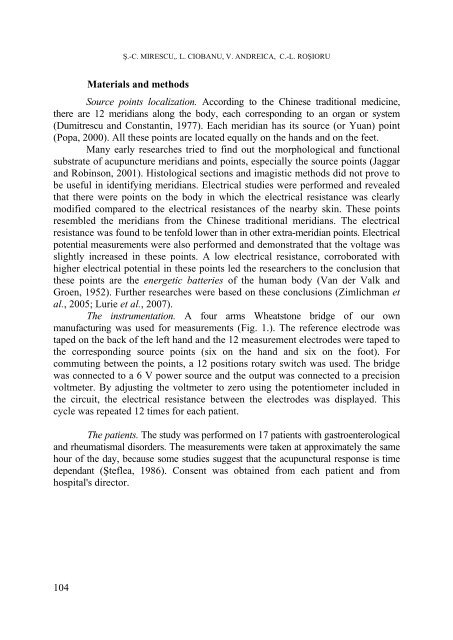biologia - Studia
biologia - Studia
biologia - Studia
Create successful ePaper yourself
Turn your PDF publications into a flip-book with our unique Google optimized e-Paper software.
Ş.-C. MIRESCU,. L. CIOBANU, V. ANDREICA, C.-L. ROŞIORU<br />
Materials and methods<br />
Source points localization. According to the Chinese traditional medicine,<br />
there are 12 meridians along the body, each corresponding to an organ or system<br />
(Dumitrescu and Constantin, 1977). Each meridian has its source (or Yuan) point<br />
(Popa, 2000). All these points are located equally on the hands and on the feet.<br />
Many early researches tried to find out the morphological and functional<br />
substrate of acupuncture meridians and points, especially the source points (Jaggar<br />
and Robinson, 2001). Histological sections and imagistic methods did not prove to<br />
be useful in identifying meridians. Electrical studies were performed and revealed<br />
that there were points on the body in which the electrical resistance was clearly<br />
modified compared to the electrical resistances of the nearby skin. These points<br />
resembled the meridians from the Chinese traditional meridians. The electrical<br />
resistance was found to be tenfold lower than in other extra-meridian points. Electrical<br />
potential measurements were also performed and demonstrated that the voltage was<br />
slightly increased in these points. A low electrical resistance, corroborated with<br />
higher electrical potential in these points led the researchers to the conclusion that<br />
these points are the energetic batteries of the human body (Van der Valk and<br />
Groen, 1952). Further researches were based on these conclusions (Zimlichman et<br />
al., 2005; Lurie et al., 2007).<br />
The instrumentation. A four arms Wheatstone bridge of our own<br />
manufacturing was used for measurements (Fig. 1.). The reference electrode was<br />
taped on the back of the left hand and the 12 measurement electrodes were taped to<br />
the corresponding source points (six on the hand and six on the foot). For<br />
commuting between the points, a 12 positions rotary switch was used. The bridge<br />
was connected to a 6 V power source and the output was connected to a precision<br />
voltmeter. By adjusting the voltmeter to zero using the potentiometer included in<br />
the circuit, the electrical resistance between the electrodes was displayed. This<br />
cycle was repeated 12 times for each patient.<br />
The patients. The study was performed on 17 patients with gastroenterological<br />
and rheumatismal disorders. The measurements were taken at approximately the same<br />
hour of the day, because some studies suggest that the acupunctural response is time<br />
dependant (Şteflea, 1986). Consent was obtained from each patient and from<br />
hospital's director.<br />
104
















